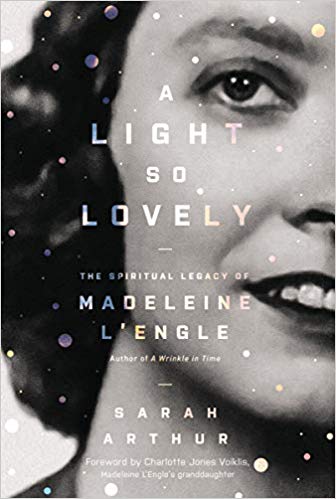A Light So Lovely:
The Spiritual Legacy of the Life of Madeleine L’Engle
by Sarah Arthur
–Review by Teri Hyrkas
When she was a teenager, Sarah Arthur knew of Madeleine L’Engle’s award winning book, A Wrinkle In Time, but didn’t read it because she was not drawn to what sounded like science fiction. Later, while a student at Wheaton College, Arthur went through a “dark night of the soul” in her faith. During this time her college roommate shared some of L’Engle’s nonfiction books with Arthur, among them, The Rock That Is Higher: Story As Truth and Walking On Water. Arthur writes: “I can’t overstate the gift that Madeleine was to this mainline evangelical.”
Sarah Arthur’s biography of L’Engle, A Light So Lovely: The Spiritual Legacy of the Life of Madeleine L’Engle (Zondervan, 2018), tells the story of the beloved author, educator, and mentor who Arthur describes as “[A] Christian author who could function quite unperturbedly from inside paradox, who dared to question the assumption that everything must be either/or. Why can’t it be both/and? What is this nonsense about “secular”? Why can’t God use those things if God wants to? Why can’t God speak through this or that person (if God can speak through a donkey, for instance)? Who says?”
“The more I learned about [L’Engle],” writes Arthur, “the more I realized, like so many hundreds of thousands of readers, that I had found an icon. Not an idol whom one worshipped — as Madeleine herself would correct us — but a window, a person whose life and faith points beyond itself to Christ.”
November 29, 2018, will mark the 100th anniversary of Madeleine L’Engle’s birth and it has been over fifty years since A Wrinkle in Time was published and became a surprise best seller. It seems fitting that Arthur’s biography of L’Engle would testify to the longevity of Wrinkle, it’s power to surprise, delight and challenge young readers, and its history of being the source of suspicion in many spheres. Wrinkle caused enough bad vibes in both secular and Christian groups to earn it a place on the list of Banned Books. Arthur refers to L’Engle as “the patron saint of banned books,” one who was “unashamedly Christian. Who loved Christ. Who talked about Christ — in her life, in her books. And who won a Newberry anyway.”
After L’Engle’s Newberry Award, Arthur writes, “[Madeleine] began publishing creative nonfiction…and suddenly she found herself another niche. Now her audience included not just the young adults she originally wrote for, but also their grown-up selves as they attempted to make sense of their religious beliefs and vocations on the ground, in their everyday lives.”
Arthur includes a quote from poet Luci Shaw about Madeleine’s creative nonfiction: “In that curious and artificial divide between the secular and spiritual worlds, there has long been a dearth of effective interpreters — communicators who can bridge a gap by planting a foot firmly in both worlds and representing each to each with integrity and enthusiasm. Madeleine L’Engle, as one such mediatrix, has made an astonishing contribution to contemporary culture.”[1]
A Light So Lovely also incorporates comments from a private Facebook group of artists whose experience in the church has been less than positive. To this group Arthur posed a question: “Who here can claim that Madeleine saved their faith/art/life?” Among the many responses is one from a young man, Thomas Bona, who told of a time that he had been so traumatized by public shaming from a church leader that he considered abandoning his faith. A person who had witnessed the event sent Bona a collection of books, some of which were by L’Engle. L’Engle’s books revived him, he said, especially her sense of “joyful uncertainty.” When Bona returned to school, “Madeleine was there waiting for me.” Unbeknownst to him, L’Engle had been scheduled to speak at his college. He related, “I felt so blessed that God shared with me her work that summer in a really painful, really vulnerable time.”
In her book Sarah Arthur states that she had two purposes for writing A Light So Lovely: one was to understand L’Engle’s thinking about the intersection of seeming opposites — fact and fiction, sacred and secular, etc. The other was to consider how Madeleine L’Engle’s body of work might influence the way people of faith discuss dissimilar or conflicting views today. Arthur expresses an urgent hope that Christians use this familiar quote of Madeleine’s as a guide to crucial conversations:
“We draw people to Christ not by loudly discrediting what they believe, by telling them how wrong they are and how right we are, but by showing them a light so lovely that they want with all their hearts to know the source of it.” To see people at variance embrace Madeleine L’Engle’s gracious approach to sharing Jesus would surely be good news, especially in our present climate of political and religious contention.
Filled with solid research, anecdotes, interviews with Madeleine’s friends and colleagues, and some less than flattering family observations about L’Engle, A Light So Lovely provides a clear-eyed yet sympathetic examination of L’Engle’s distinguished career. This book would be a perfect companion volume for book clubs that chose to read any of L’Engle’s nonfiction titles.
[1] Luci Shaw, in the forward to Suncatcher: A Study of Madeleine L’Engle and Her Writing by Carole F. Chase (Philadelphia: Innisfree Press, 1995, 1998),13.

